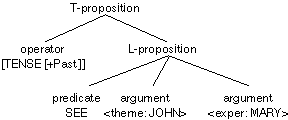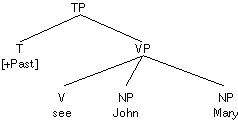![]() Internal Subject
Hypothesis
Internal Subject
Hypothesis![]()
Linguistics 322
![]()
![]() Until recently, linguists
assumed that the subject of the sentence was generated in the
position immediately dominated by S. The node 'S' plays no role
in the x-bar theory. Here, we will replace S with TP, the maximal
level of the projection of T (tense).:
Until recently, linguists
assumed that the subject of the sentence was generated in the
position immediately dominated by S. The node 'S' plays no role
in the x-bar theory. Here, we will replace S with TP, the maximal
level of the projection of T (tense).:


The lexical proposition (1b) is called a small clause in syntax (see small clauses). A small clause is a lexical projection of X. Clauses are called small clauses if they occur as the complement of a lexical category as opposed to the complement of tense. We will discuss just two types here--one argument projections (monadic) and two-argument projections (dyadic). There are two types of monadic projection. The first includes unaccusative verbs. An unaccusative verb has the following structure at D-structure:
(5)
The complement of an unaccusative verb is usually assigned the theta role patient (see theta roles). Examples of unaccusative verbs include: melt, break, thicken, cook, open, close. Most verbs of this class have a corresponding transitive verb whose subject is an agent; cf.:
(6) The stew is cooking.
(7) The chef is cooking the stew.
Stew is the patient, chef is the agent.
The second type of monadic structure includes ergative verbs. The subject of ergative verbs is usually associated with agency. This class has the following structure. All ergative verbs are intransitive Suppose we consder the only argument to be initially assigned to the complemen of the verb:
(8)
The complement must raise. ONe factor that accounmts its raising is the Exended Proejction Princple. The second is the for NP to be marked with Case (Case Theory): The fundamentl principle of Case Theory is:
(9) Case Filter
*NP if NP has phonetic form and no Case.
Case (with a capitol C) is a special relationship affecting noun phrases. Normally a noun phrase complement receives its Case from the head governing it. However, a verb cannot assign Case to its complement if there is no subject. In (8) there is no subject. The head verb cannot, therefore, assign Case to its complement. There are various strategies available for a NP to receive Case. The first strategy is for the NP to raise to a position iwhere it maight be assigned Case. The first such movement moves up to XP--in the two level theory, it is adjoined to XP:
(10)
In the three level X-bar theory, when NP moves to XP, the XP is realized as X-bar, a sister of the raised NP. These two nodes are dominated by XP:
(11)
One of the difference between an unaccusative verb and an ergative verb, is that the NP must raise if the verb is an ergative verb, but it does not have if the verb is unaccusative.
The subject of an ergative verb is an agent. These verbs have no unaccusative counterpart: go, run, walk, swim, jump, fly, crawl:
(12) John runs to the store everyday.
(13) Mary is walking to school.
(14) The birds are flying around the trees.
The dyadic projection has the following structure:
(15)
The subject of a dyadic verb is often an agent or experiencer. Less frequently is can be some other theta role (see theta roles):
(16) a. John built a house.
b. Mary made dinner.
c. Heloise wrote a book.
d. Bill is walking the dog.
e Sally is flying a kite.
![]() The basic proposition
may be modified by tense. In (1a) it is the past tense:
The basic proposition
may be modified by tense. In (1a) it is the past tense:
(17) [+PAST [ SEE <MARY> < JOHN> ]].
In the D-structure which we have been proposing till now, Mary is generated to the left of T, and dominated by S. Why should this be the case? Mary is closely associated with the verb see. Suppose that we consider the basic proposition to be VP, and that Mary is adjoined initially to VP in the syntax. In other words, the grammatical proposition is mapped into the following syntactic structure:
(18)
The rule Raising-to-subject applies here: the subject Mary raises (see raising) to and is adjoined to TP because Mary fails to be marked for Case in (16):
(19)
Now we have the structure which we originally said was the D-structure of Mary saw John., except now S is TP. This is a desirable consequence since S was an anomalous node up until now. The head of S was unobvious. The head is now T. Note that the head of the sentence (CP) is C. What is traditionally considered a sentence is not the former node S. Note in the X-bar analysis, the lower TP is 'T-bar', and the lower VP is 'V-bar':
(18)
![]()
![]() Go to Argument
Assignment
Go to Argument
Assignment
![]() To return to course outline Click
here.
To return to course outline Click
here.
![]()
This page last updated 29 SE 99.